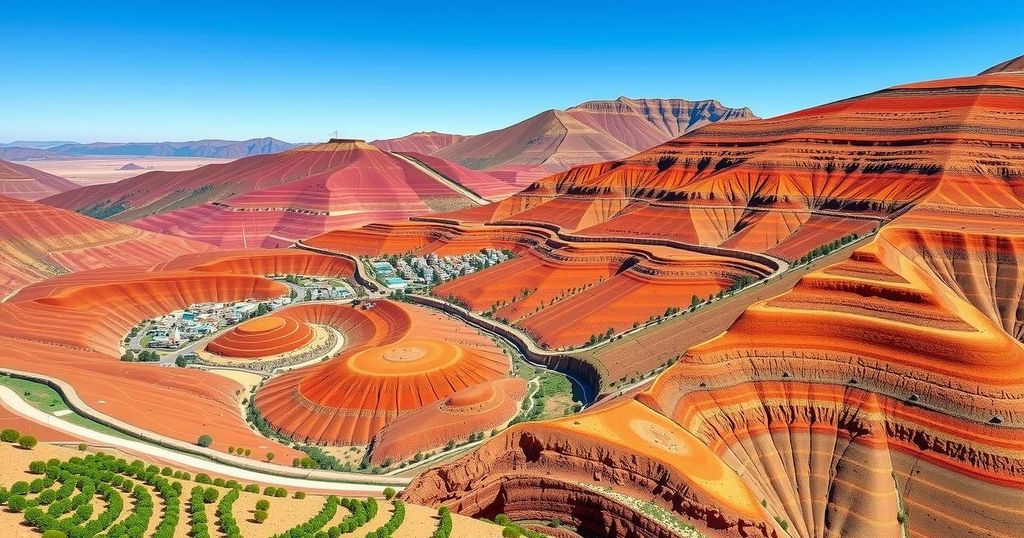Morocco’s Cobalt Frontier Is Emerging as a Key Player

- Morocco is emerging as a crucial cobalt production hub amid rising electric vehicle demand.
- Catalyst Mines Inc. made a significant cobalt discovery near Amassine, hinting at a $60 billion potential.
- Historical cobalt production has centered around Bou Azzer, but the gap could be filled by Amassine.
- The Moroccan government aims to attract investments and enhance the local infrastructure through cobalt production.
- Chinese investments in Morocco heighten the competitive landscape for cobalt minerals.
Morocco’s cobalt supply could reshape the battery market
Morocco’s Rising Cobalt Industry Gathers Momentum As the demand for electric vehicles continues to surge, Morocco is positioning itself as a new hub for cobalt production. This shift is particularly crucial considering that every tonne of cobalt that bypasses the bottleneck in the Democratic Republic of Congo (DRC) alters the global battery market dynamics. Tracy Hughes, Executive Director of the Critical Minerals Institute, stated that a scalable and low-carbon cobalt supply from Morocco would diversify risks for automakers and establish a value chain that aligns with the ESG (Environmental, Social, and Governance) standards increasingly emphasized by North American and European manufacturers.
Amassine project might close production gaps
Catalyst Mines Inc. Charts a New Course for Cobalt The ongoing development in Morocco reached a significant milestone last April when Catalyst Mines Inc. made an impressive mineral discovery near the Berber village of Amassine. They dug hand-made trenches into the hillside, uncovering serpentinite laden with chrome, nickel, and cobalt. Preliminary reports suggest a staggering in-ground value of over $60 billion, based on approximately 609 million tonnes of mineralized rock. This potential volume, if validated, could exceed all previously recorded cobalt occurrences in Morocco. Historically, Morocco’s cobalt aspirations have revolved around the Bou Azzer mine, which has maintained a steady – albeit low – production of about 1,500 tonnes annually. However, it is the innovative work at Amassine that could fill the gap left by Bou Azzer’s dwindling output.
Infrastructure and policies elevate Morocco’s cobalt strategy
Geological Riches and Strategic Initiatives Spark Industry Hopes Beyond just geology, the infrastructure and political landscape will be crucial for turning these mineral discoveries into marketable resources. A notable project is a cobalt-sulphate refinery near Marrakech, with a significant investment of $100 million from Managem, poised to begin producing battery-grade outputs in 2025. Such advancements could mean that Amassine has a predictable outlet for its resources—this aspect is particularly appealing considering existing free-trade agreements with the EU and the US, enhancing Morocco’s position as a viable alternative to the current supply chains that are heavily reliant on the DRC and Indonesia.
Chinese investment signals shift in cobalt dynamics
Growing Competition and Global Relations Shift Focus The interest from Chinese companies adds another layer of complexity to this emerging market landscape. COBCO, a firm from China, is constructing a nickel and cobalt refinery in collaboration with Moroccan state entities, which will supply battery producers both domestically and internationally. Moreover, a separate partnership with the Moroccan royal holding company is aimed at exploring and developing additional battery metal assets. These developments signify a strategic effort by China to extend its influence in the Atlantic corridor, especially in light of the vulnerabilities in supplies from Central Africa.
Catalyst Mines aims for local community benefits
The Socioeconomic Upsides for Local Communities Are Significant The geographical region of Siroua, where the Amassine project is located, suffers from high rates of underemployment. There are compelling prospects for local communities if projects like Amassine proceed responsibly, as they could lead to the creation of needed infrastructure such as roads and clinics. Catalyst acknowledges the potential of the Amassine region to provide long-term benefits akin to those the Bou Azzer mine has provided for generations, underlining the importance of adhering to all local labor and environmental regulations.
Amassine could redefine Morocco’s cobalt status
Morocco’s Future in Cobalt Remains Promising and Strategic Cobalt is crucial in many modern applications, not only for electric vehicle batteries but also in turbine super alloys. The Amassine site has the potential to transform Morocco from its current position as the ninth-largest cobalt producer to a player in the top five globally, particularly important as regions like Washington and Brussels advocate for sourcing these critical minerals responsibly. If Catalyst Mines succeeds, it would effectively position Morocco on the global cobalt map, leveraging its resources as alternative sources emerge to compete against traditional markets dominated by the DRC.
In conclusion, the developments at Catalyst Mines Inc.’s Amassine project in Morocco signal a notable potential shift in the global cobalt market. With promising geological discoveries and increasing demand for electric vehicle batteries, Morocco is on track to increase its production and address the challenges posed by relying on the DRC. The strategic partnerships forming around the cobalt sector, both from local and international players, will be essential in transforming Morocco into a significant player in the global supply chain of critical minerals.





